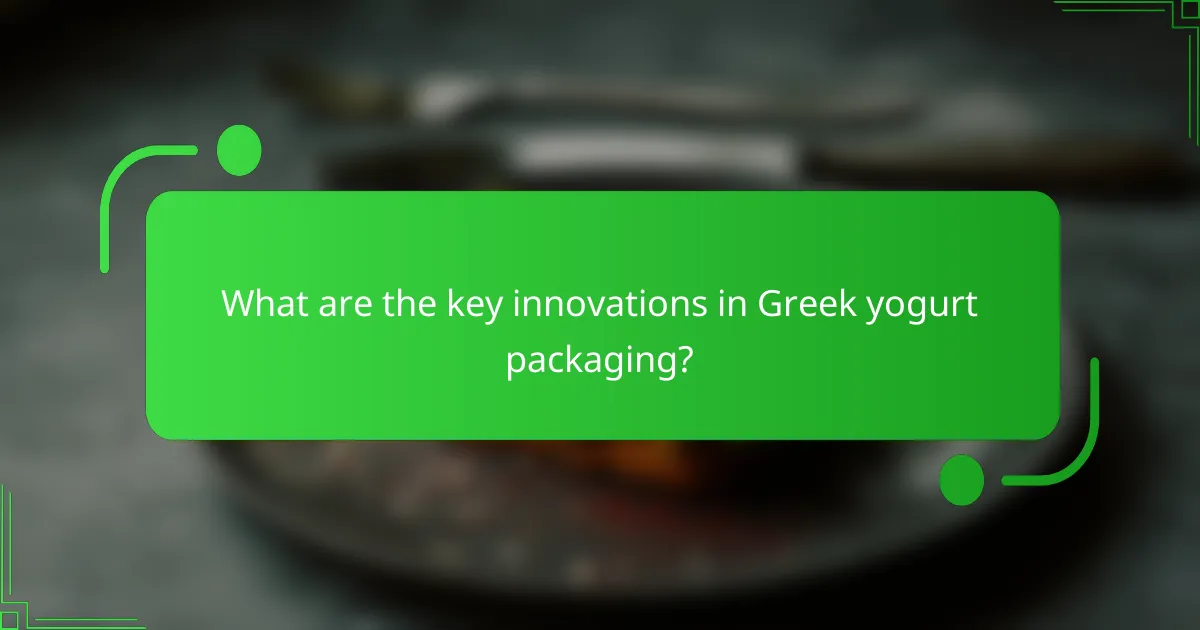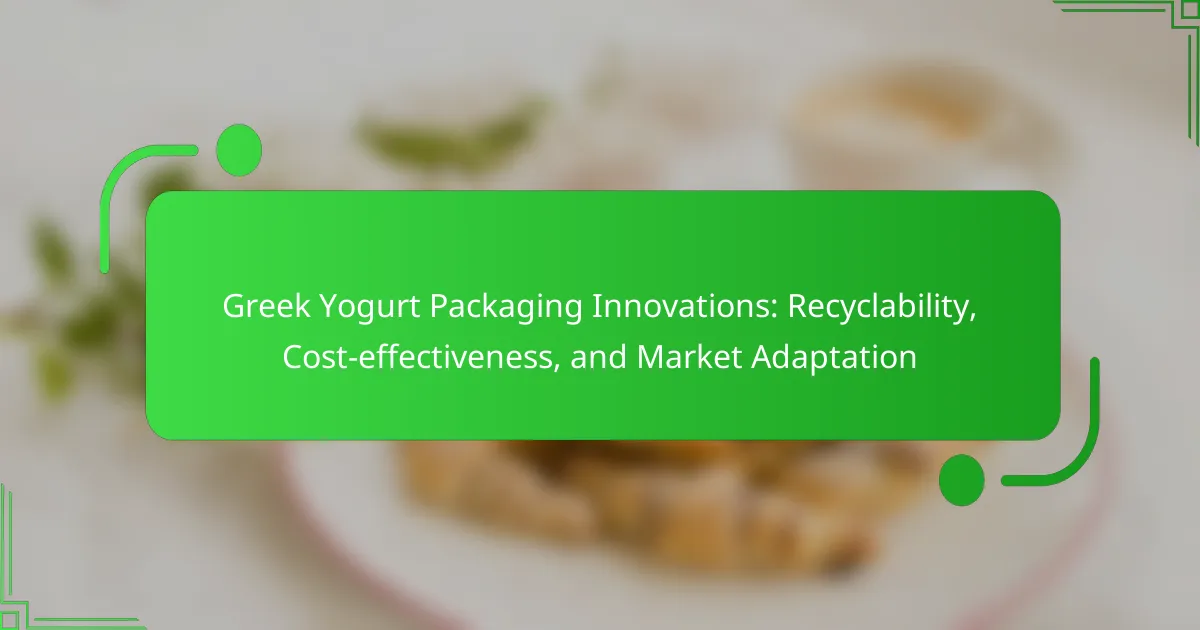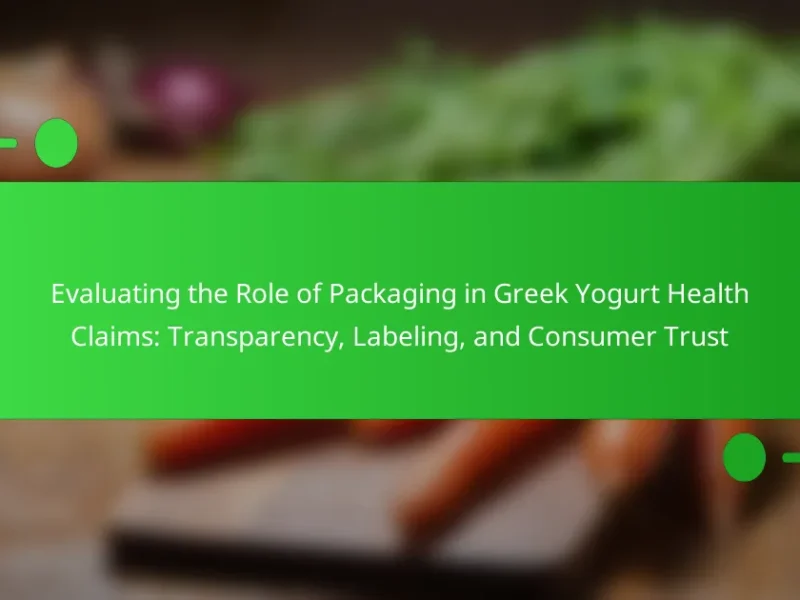Greek yogurt packaging innovations focus on enhancing sustainability, convenience, and usability. Key developments include the adoption of biodegradable materials that minimize environmental impact, portion control designs that meet consumer demand for health and convenience, and resealable features that improve product longevity. These innovations reflect the industry’s response to market trends prioritizing recyclability, cost-effectiveness, and practical solutions in food packaging. The article will explore these advancements and their implications for the Greek yogurt market.

What are the key innovations in Greek yogurt packaging?
Key innovations in Greek yogurt packaging include the use of biodegradable materials, portion control designs, and resealable features. Biodegradable materials reduce environmental impact. Portion control designs cater to consumer preferences for convenience and health. Resealable features enhance product longevity and usability. These innovations respond to market demands for sustainability and practicality in food packaging.
How do these innovations enhance recyclability?
Innovations in Greek yogurt packaging enhance recyclability by utilizing materials that are more easily processed. These materials often include mono-materials that simplify the recycling stream. By reducing the complexity of packaging, fewer contaminants are introduced during recycling. Innovations also involve designing packages that are more efficient to disassemble, facilitating better sorting. Additionally, some packaging innovations incorporate recycled content, promoting a circular economy. These advancements lead to higher recycling rates and lower environmental impact. According to the Association of Plastic Recyclers, simpler packaging designs can increase recycling efficiency by up to 30%.
What materials are being used to improve recyclability in Greek yogurt packaging?
Recyclability in Greek yogurt packaging is being improved through the use of materials such as PET (polyethylene terephthalate) and biodegradable plastics. PET is widely recyclable and can be reused in various applications. Biodegradable plastics, made from renewable resources, offer an alternative that breaks down more easily in the environment. Innovations also include using paper-based materials for outer packaging, which enhances recyclability. Studies have shown that these materials can significantly reduce environmental impact. For instance, a report by the European Commission highlights the benefits of using recyclable materials in food packaging. This aligns with growing consumer demand for sustainable practices.
How does the design of packaging contribute to its recyclability?
The design of packaging significantly influences its recyclability. Packaging materials that are easily separable enhance recycling processes. For example, single-material packaging is often more recyclable than multi-material designs. Clear labeling of recyclable materials aids consumers in proper disposal. Minimal use of adhesives and coatings can improve the recyclability of packaging. Research indicates that 70% of consumers prefer packaging that is easy to recycle. Sustainable design practices, such as using biodegradable materials, also contribute to overall recyclability. Therefore, thoughtful packaging design can greatly enhance recycling rates and reduce environmental impact.
What is the impact of cost-effectiveness on Greek yogurt packaging?
Cost-effectiveness significantly influences Greek yogurt packaging decisions. It drives manufacturers to select materials that minimize production and shipping costs. This approach often results in lighter packaging, reducing transportation expenses. Additionally, cost-effective packaging can enhance shelf life, benefiting both producers and consumers. Research indicates that 60% of yogurt brands prioritize cost in packaging choices. Sustainable materials may be overlooked if they increase costs. Ultimately, cost-effectiveness shapes the balance between quality, sustainability, and market competitiveness in Greek yogurt packaging.
How do packaging innovations affect production costs for Greek yogurt?
Packaging innovations can significantly affect production costs for Greek yogurt. Advanced materials and designs can lead to higher initial expenses. However, these innovations often result in improved shelf life and reduced spoilage. For instance, vacuum-sealed packaging can keep yogurt fresher for longer, minimizing waste. This can lower overall costs in the supply chain. Moreover, eco-friendly packaging solutions may attract more customers, potentially increasing sales. Efficient packaging designs can also optimize storage and transportation, reducing logistics costs. Overall, while initial costs may rise, long-term savings and benefits can offset these increases.
What are the economic benefits of adopting cost-effective packaging solutions?
Cost-effective packaging solutions lead to significant economic benefits for businesses. They reduce material costs by utilizing less expensive or lighter materials. This decrease in material usage can lower production expenses. Cost-effective packaging also minimizes shipping costs due to reduced weight and volume. According to a study by Smithers Pira, companies can save up to 20% on logistics with optimized packaging. Furthermore, sustainable packaging can enhance brand image, attracting environmentally conscious consumers. This can lead to increased sales and customer loyalty. Overall, adopting cost-effective packaging solutions boosts profitability while promoting sustainability.
How is the Greek yogurt market adapting to packaging innovations?
The Greek yogurt market is adapting to packaging innovations by implementing eco-friendly materials and redesigning packaging formats. Brands are shifting towards recyclable and biodegradable packaging to meet consumer demand for sustainability. This adaptation helps reduce environmental impact and aligns with global recycling initiatives. Additionally, companies are exploring portion-controlled packaging to enhance convenience for consumers. Innovations include resealable containers and single-serve packs, catering to on-the-go lifestyles. These changes reflect a broader trend in the food industry towards sustainable and user-friendly packaging solutions. The market’s response is driven by consumer preferences and regulatory pressures for sustainable practices.
What consumer trends are influencing packaging choices in the Greek yogurt industry?
Sustainability is a key consumer trend influencing packaging choices in the Greek yogurt industry. Consumers increasingly prefer eco-friendly packaging options. This shift is driven by growing environmental awareness. Many brands are adopting recyclable materials to meet consumer demand. Additionally, convenience plays a significant role in packaging decisions. Single-serve containers are gaining popularity for their ease of use. Cost-effectiveness is also crucial, as brands seek to balance quality and affordability. Research indicates that 74% of consumers are willing to pay more for sustainable packaging. These trends are reshaping how Greek yogurt is packaged in the market.
How are brands responding to sustainability demands in their packaging strategies?
Brands are responding to sustainability demands by adopting eco-friendly packaging materials. Many companies are shifting to recyclable and biodegradable options. This transition helps reduce plastic waste in landfills and oceans. For instance, Greek yogurt brands are increasingly using paper-based containers. Research indicates that 70% of consumers prefer brands with sustainable practices. Additionally, brands are investing in innovative designs that minimize material use. These strategies not only meet consumer expectations but also comply with regulatory standards.
What challenges do manufacturers face with packaging innovations?
Manufacturers face several challenges with packaging innovations. One major challenge is the need for sustainable materials. Many consumers demand eco-friendly packaging, which can be more expensive and harder to source. Cost-effectiveness is another significant issue. Innovative packaging solutions often require higher initial investments, impacting profit margins. Additionally, manufacturers must ensure that packaging maintains product quality. For Greek yogurt, this means preventing spoilage and maintaining freshness. Regulatory compliance also poses challenges. Packaging must meet health and safety standards, which can vary by region. Lastly, market adaptation is crucial. Manufacturers must stay ahead of trends to meet consumer preferences. This requires ongoing research and development efforts.
How do regulatory requirements impact Greek yogurt packaging innovations?
Regulatory requirements significantly influence Greek yogurt packaging innovations. These regulations often mandate specific standards for safety, labeling, and environmental impact. Compliance with these rules drives manufacturers to innovate in materials and designs. For instance, regulations promoting recyclability lead to the development of eco-friendly packaging options. Additionally, labeling requirements compel brands to enhance clarity and transparency in their packaging. This can include nutritional information and ingredient sourcing. Innovations also focus on cost-effectiveness to meet budget constraints imposed by regulatory compliance. Overall, regulatory frameworks shape the direction and nature of packaging innovations in the Greek yogurt industry.
What are the logistical challenges in implementing new packaging technologies?
Implementing new packaging technologies presents several logistical challenges. These challenges include the need for retraining staff to handle new materials and processes. Additionally, supply chain disruptions may occur due to sourcing new packaging materials. Compatibility with existing production lines can also pose issues, requiring potential machinery upgrades. Transportation and storage considerations may change, affecting cost and efficiency. Furthermore, regulatory compliance for new materials can complicate implementation. Finally, market acceptance of new packaging can influence overall success, as consumer preferences may shift.
What are the future trends in Greek yogurt packaging innovations?
Future trends in Greek yogurt packaging innovations include increased use of sustainable materials. Companies are focusing on biodegradable and recyclable packaging options. This shift aligns with consumer demand for environmentally friendly products. Smart packaging technologies are also emerging. These technologies can monitor freshness and provide real-time information to consumers. Cost-effective packaging solutions are being prioritized to reduce overall production expenses. Additionally, brands are exploring portion-controlled packaging formats. Such formats cater to on-the-go consumption preferences. These trends indicate a significant evolution in the Greek yogurt packaging landscape.
How might advancements in technology shape the future of Greek yogurt packaging?
Advancements in technology will enhance the future of Greek yogurt packaging through improved materials and smart features. Innovations in biodegradable and recyclable materials will reduce environmental impact. For instance, plant-based plastics can replace traditional petroleum-based options. Smart packaging technologies will enable real-time freshness tracking. Sensors can indicate product quality and shelf life, enhancing consumer trust. Automation in production will lower costs and increase efficiency. These advancements will cater to growing consumer demand for sustainability and convenience. According to a 2022 report by Grand View Research, the global sustainable packaging market is expected to reach $500 billion by 2027, reflecting this trend.
What role will consumer preferences play in the evolution of packaging design?
Consumer preferences will significantly influence the evolution of packaging design. As consumers increasingly prioritize sustainability, packaging will need to adapt to incorporate recyclable and biodegradable materials. Research indicates that 74% of consumers are willing to pay more for sustainable packaging options. This shift will drive brands to innovate and enhance their packaging strategies. Additionally, convenience and functionality will remain critical factors in design choices. Brands that align their packaging with consumer preferences will likely gain a competitive advantage in the market. This trend is evident in the Greek yogurt sector, where brands are already exploring eco-friendly packaging solutions to meet consumer demands.
What best practices should brands follow for sustainable Greek yogurt packaging?
Brands should prioritize recyclable materials for sustainable Greek yogurt packaging. Using materials like PET or glass enhances recyclability. Brands should also minimize packaging size to reduce material usage. Incorporating plant-based inks can further lessen environmental impact. Clear labeling on recyclability encourages proper disposal by consumers. Collaborating with recycling programs can improve recovery rates of packaging materials. Brands should also consider life cycle assessments to evaluate environmental impact. These practices align with growing consumer demand for sustainability in food packaging.
The main entity of this article is Greek yogurt packaging innovations. The article outlines key advancements in packaging, including the use of biodegradable materials, portion control designs, and resealable features that enhance recyclability and meet consumer demands for sustainability and convenience. It discusses how these innovations affect production costs and the economic benefits of adopting cost-effective solutions. Additionally, the article highlights the challenges manufacturers face in implementing new technologies and the influence of consumer trends on packaging design, while providing best practices for sustainable packaging in the Greek yogurt market.


